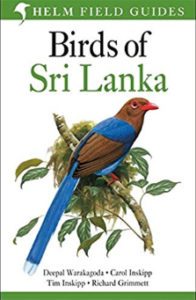Birds of Sri Lanka Field Guide
 Birds of Sri Lanka Field Guide
Birds of Sri Lanka Field Guide
The question of which field guide to recommend for birding tours in Sri Lanka is easy to answer; Birds of Sri Lanka, published by Helm. This is a natural choice as most of the alternatives are photographic field guides which cannot compare similar species accurately and rarely show both male and female plumages. Specifically published for this country alone this is a light weight field guide that is truly suitable for use in the field. Currently this is the most up-to-date guide for Sri Lanka. Listing key subspecies also makes it is easy to understand where this book is at variance to current taxonomies.
Birds of Sri Lanka is the field guide that we will be using on all of our birding tours to this endemic-rich country:
This exciting itinerary is more enjoyable when using the Birds of Sri Lanka field guide. Using an older guide is likely to cause a lot of confusion over taxonomy.
Range Maps
All species in the main body of this book have range maps, which display their distribution within Sri Lanka. These appear on the page opposite that which contain the illustrations, making referral between them very easy. Vagrant species recorded in Sri Lanka do not get range maps, indeed they only appear in an appendix at the back of the book. The range maps clearly indicate resident species, winter migrants and summer visitors; they are easy to understand.
Illustrations
The illustrations are generally good and there is a consistency of style throughout the book. However, there are a few problems, most notably some of the babblers which seem elongated, possibly an error in the printing process. Some warblers suffer the same problem but most plates allow for easy identification of the birds shown. All illustrations are in colour and show a good level of detail depicting both males and females where relevant. The large majority of species appear in poses that are typically seen in the field, which goes a long way to making identification easy. However, some of the illustration pages are rather overcrowded and considering how slim the book is it seems like some plates would be clearer if distributed across a slightly higher number of pages. The shorebird pages would benefit from this in particular.
Species Accounts
The species accounts are very concise. The most useful information within them are details on each bird’s status as well as the habitats of choice. The size of each species is clearly indicated and voice descriptions are only expanded where they are useful instead of being long and meaningless. Most of the space for the species accounts deals with the descriptions which are adequate for purpose but including useful information about behaviour would be a better way to use this space.
The text is moderately useful but not highly enlightening and unfortunately the font size is rather small making it tricky to read. The species accounts are perhaps the weakest aspect of this Birds of Sri Lank field guide.
Other Features
This publication contains a quite thorough introduction which gives details of the main habitat types of Sri Lanka and the key endemic species that live within them. There is also a section on the key bird watching sites around the country which makes it easy to see where one will be traveling. A pictorial index at the front is also good but perhaps, given the small size of the book, is unecessary. A list of the statuts of all key species is a nice feature. The back of the book contains an appendix listing all vagrant species recorded in Sri Lanka and the index is clear, well laid out and is easy to use.
Recommended
We highly recommend purchasing a copy of Birds of Sri Lanka well in advance of joining our tour for endemic species. Ensure that you order your copy in time for it to arrive before you depart to begin this tour. This is the field guide the guides leading this Sri Lanka birding tour will be using.
